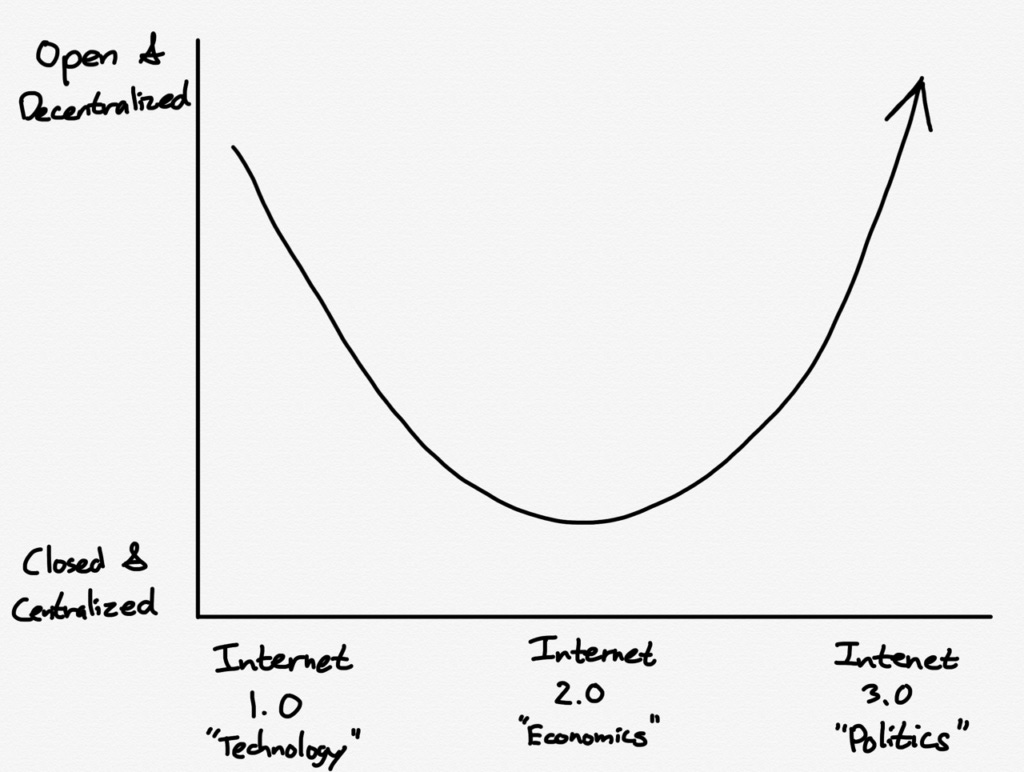Will we remain trapped in centralised systems that seek to monetise our attention and emotions, or is there a brighter future beyond this stage of the internet’s development? This week has shown us glimpses of hope for society with a new President in the USA and also the first signs of success in vaccination against COVID-19, but perhaps we can also dream about healthier, more innovative technology platforms to connect us.
Re-decentralisation?
Ben Thompson wrote a typically thoughtful piece recently about the future of the internet, starting from an observation about Fukuyama’s widely misunderstood thesis about the End of History and going on to suggest that the next phase (which he dubs Internet 3.0) will be shaped, largely by questions of politics and sovereignty:

© Stratechery LLC 2021
Of course, this could be very messy, with so many tectonic plates of local, regional, economic and ideological interests grinding against each other in ways we may not be able to predict, but the glimmer of hope in this idea is a return to a de-centralised internet that can escape the distorting effects of ad-tech and eyeball economics.
It is constantly shocking to me how awful most website are today if you turn off prophylactic ad-blockers and anti-tracking scripts compared to what we had in the early 2000s. In a way, this mirrors the decline and pollution of the public sphere that Facebook and other platforms have caused, whether by accident or design.
Eduployment and Multi-Player Enterprises
Scott Belsky also picks up on the de-centralisation theme in an interesting post I found via Stowe Boyd’s informative newsletter, but goes on to make some fascinating predictions about the near-future of tech. Three in particular stood out for me:
-
“The Era of Eduployment: Identifying a trade, getting an education, and getting a job (or starting a company) become fully integrated.
-
More and more niche functions of the enterprise will become multi-player, powered by a next generation of highly specialized, AI-bolstered, enterprise companies with consumerized product experiences.
-
Creativity tools will be deployed across the enterprise, much like productivity tools were deployed in previous decades”.
On a more prosaic level, this chimes with what many see as the immediate future of digital transformation, with much greater focus on the foundations and wiring of service-oriented architectures, platforms, data and composability of apps and functions (including lo- and no-code approaches). Vala Afshar of Salesforce covered some of these basics here.
But perhaps this thinking about creativity and multi-player enterprises also intersects with the ongoing challenge of how to improve employee experience in a remote-first working context. The Financial Times shared a ‘Big Read’ article recently ($ paywall) on how different firms are trying different techniques to avoid losing the ‘creativity’ in the current online-only digital workplace, which was quite positive about how online workshops, discussions and brainstorming sessions are filling the meeting room-shaped gap (remember them?) created by the pandemic.
Perhaps we will see the digital workplace platforms and services come to life in very different and personalised ways using lo- and no-code systems that allow each individual or team to design a working environment and pipeline tailored to their specific needs, much like the customisation and variation we see within a single multi-player game world. This seems to be consistent with the variably-layered architecture we believe is necessary to underpin post-bureaucratic organisations: integration and standardisation of foundational services in a platform to support infinite variety of apps and experiences on top.
Bonus Link
A bit of history homework on how Claude Shannon was able to imagine information theory in advance of the tools being widely available to observe it in action: https://www.quantamagazine.org/how-claude-shannons-information-theory-invented-the-future-20201222/. If he can do that, perhaps we can imagine the future of work during lockdown.

